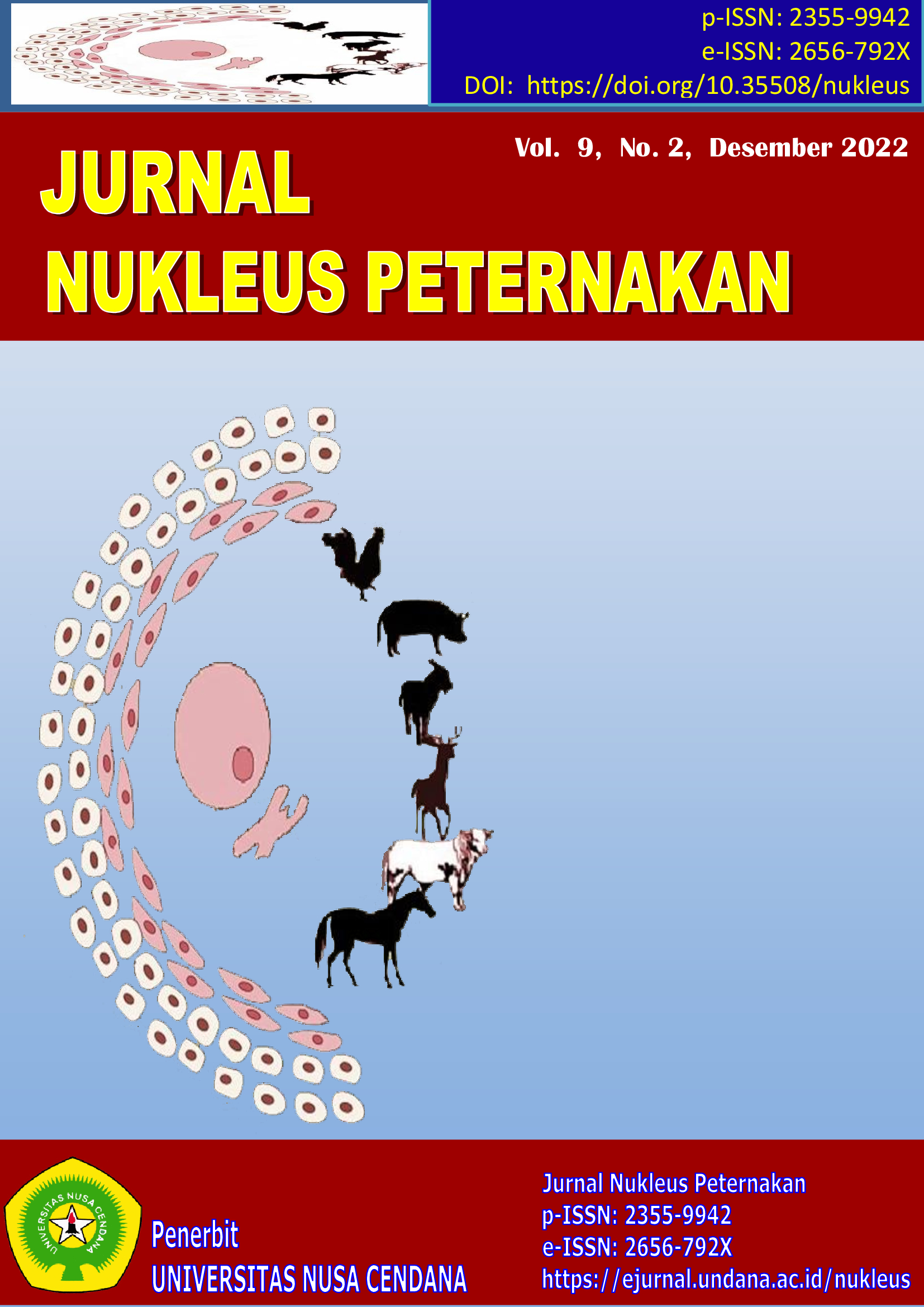PENGGUNAAN TEPUNG TALAS SEBAGAI SUBSTITUSI TEPUNG TAPIOKA TERHADAP KARAKTERISTIK FISIKOKIMIA DAN ORGANOLEPTIK BAKSO DOMBA (Using of taro flour as a substitute of tapioca flour on physicochemistryl and organoleptic characteristics of lamb meatballs)
Abstract
Lamb meatballs are rarely found in the market, because lamb meat has a distinctive aroma. One way to reduce the distinctive aroma of lamb meatballs is to use various types of flour in combination with tapioca flour. The purpose of this study was to determine the quality of meatballs processed from lamb and given taro flour as a substitute for tapioca flour. A completely randomized design (CRD) 5 x 4 was used in this experiment. The five treatments used were: T0 = no taro flour (control); T25=25% taro flour 25%; T50 = 50% taro flour; T75 = 75% taro flour; T100 = 100% taro flour, and each unit was tested four times. Parameters measured were: pH, water holding capacity (WHC), cooking loss, water and fat content, aroma, color, elasticity and taste. The parametric data was analyzed using ANOVA, while the nonparametric data was analyzed using the Kruskal-Wallis test. The statistical analysis result showed that a balanced mixture of tapioca and taro (50%) caused a decrease in pH (P<0.01). The higher the percentage of taro to substitute tapioca, caused a decrease in WHC and an increase in cooking loss (P<0.05), decreased water content, increased fat content (P<0.01), but did not affect aroma, color, elasticity and taste (P>0.05). The results of this study concluded that the use of taro flour as a substitute for tapioca flour in processing lamb meatballs do not change the organoleptic value of meatballs. Taro flour can be used to replace tapioca flour in processing lamb meatballs as much as 50%.
Downloads
References
AOAC. 2005. Official Methods of Analysis. Assosiation of Official Chemist. Inc. Virginia.
Aristawati R, Atmaka W , Muhammad D R A. 2013. Subtitusi tepung tapioka ( manihot esculenta ) dalam pembuatan takoyaki subtitution of cassava flour ( Manihot esculenta). Teknosains Pangan 2(2) : 56–65.
https://jurnal.uns.ac.id/teknosains-pangan/article/view/4210/3636
Aryani, N. 2011. pengaruh konsentrasi putih telur ayam ras terhadap kemekaran kerupuk Ikan Mas (Cyprinus carpio). Journal of Tropical Fisheries 6(2): 593–596.
Badan Pusat Statistik. 2016. Populasi Ternak Domba Menurut Kabupaten/Kota. Propinsi Nusa Tenggara Timur.
Badan Standarisasi Nasional. 2014. Bakso Daging SNI-01-3818-2014. BSN. https://www.academia.edu/19596656/28853_SNI_3818_2014_BAKSO
Bulkaini, Kisworo D, Yasin M. 2019. Karakteristik fisik dan nilai organoleptik sosis daging kuda berdasarkan level subtitusi tepung tapioka. Jurnal Veteriner 20 (4): 548–557.
http://ojs.unud.ac.id/index.php/jvet
Calnan HB, Jacob RH, Pethick DW , Gardner GE. 2014. Factors affecting the colour of lamb meat from the longissimus muscle during display: The influence of muscle weight and muscle oxidative capacity. Meat Science 96 (2): 1049–1057. https://doi.org/10.1016/j.meatsci.2013.08.032
Christiningrum ND, Murniati DE. 2022. Subtitusi tepung talas dan umbi talas pada produk pangsit dan nasi bakar talas . Prosiding Pendidikan Teknik Boga Busana FT UNY 15(1): 2–7.
Eddy NO, Essien E, Ebenso EE , Ukpe RA. 2012. Industrial potential of two varieties of cocoyam in bread making. E-Journal of Chemistry 9(1): 451–464.
https://doi.org/10.1155/2012/635894
Fowler SM, Morris S, Hopkins DL. 2019. Nutritional composition of lamb retail cuts from the carcases of extensively finished lambs. Meat Science 154 . 126–132. https://doi.org/10.1016/j.meatsci.2019.04.016
Hawa LC, Wigati LP, Indriani DW. 2020. Analisa sifat fisik dan kandungan nutrisi tepung talas (Colocasia esculenta l.) pada suhu pengeringan yang berbeda. Agrointek 14(1): 36–44.
https://doi.org/10.21107/Agrointek.v14i1.6156
Insausti K, Murillo-Arbizu MT, Urrutia O, Mendizabal JA, Beriain MJ, Colle MJ, Bass PD, Arana A. 2021. Volatile compounds, odour and flavour attributes of lamb meat from the navarra breed as affected by ageing. Foods 10(3). https://doi.org/10.3390/foods10030493
Lies, S. 2009. Tepung Tapioka Pembuatan dan Pemanfaatannya. Kanisius.
Malelak GEM, Riwu ARR, Ratu MRD, Lay MR. 2021. Pelatihan pengolahan daging domba ekor gemuk pada anggota darma wanita Pemda Sabu Raijua. Jurnal Pengabdian Kepada Masyarakat LPPM Undana 15(1) :61–64.
https://ejurnal.undana.ac.id/index.php/jlppm/article/view/4112/2881
Melia S, Juliyarsi I, Rosya DA. 2010. Peningkatan kualitas bakso ayam dengan penambahan tepung talas sebagai subtitusi tepung tapioka. Ejournal.Uin-Suska.Ac.Id 7(2): 62–69. http://ejournal.uin-suska.ac.id/index.php/peternakan/article/view/460
Monego MA, Pellegrini LG, Roman SS, Kubota EH, Prestes RC, Mello RO. 2018. Is it possible to produce meatballs made with lamb from animals fed on whole cottonseed without altering the sensory characteristics. International Food Research Journal 25(6): 2486–2496. http://www.ifrj.upm.edu.my/25%20(06)%202018/(33).pdf
Montolalu S, Lontaan N, Sakul S, Mirah AD. 2017. Sifat fisiko-kimia dan mutu organoleptik bakso broiler dengan menggunakan tepung ubi jalar (Ipomoea batatas L). Zootec 32(5):
https://doi.org/10.35792/zot.32.5.2013.986
Rahmiati TM, Purwanto YA, Budijanto S, Khumaida N. 2017. Sifat Fisikokimia Tepung dari 10 Genotipe Ubi Kayu (Manihot esculenta Crantz) Hasil Pemuliaan (Physicochemical Properties of Cassava Flour (Manihot esculenta Crantz) of 10 Breeding Genotipes). Agritech 36(4): 459.
https://doi.org/10.22146/agritech.16771
Rostianti T, Hakiki D, Ariska A, Sumantri S. 2018. Karakterisasi Sifat Fisikokimia Tepung Talas Beneng sebagai Biodiversitas Pangan Lokal Kabupaten Pandeglang. Gorontalo Agriculture Technology Journal 1(2): 1. https://doi.org/10.32662/gatj.v1i2.417
Sari AH danWidjanarko BS. 2015. Karakteristik kimia bakso sapi (kajian proporsi tepung tapioka: tepung porang dan penambahan NaCl. Jurnal Pangan dan Agroindustri 3(3):784–792. https://jpa.ub.ac.id/index.php/jpa/article/view/200
Sarisando, Gemini GEM, Kale PR. 2021. Pengaruh Penggunaan Tepung Keladi (Colocasia esculenta) Sebagai Pengganti Tapioka Terhadap Kualitas Organoleptik Sosis Babi. Jurnal Nukleus Peternakan 8(1): 1–5.
https://ejurnal.undana.ac.id/index.php/nukleus/article/view/3620/2708
Sembong RS, Peka SM, Kale PR, Malelak GEM. 2019. Kualitas Sosis Babi yang Diberi Tepung Talas sebagai Pengganti Tepung Tapioka. Jurnal Nukleus Peternakan 6(1): 1–9.
http://ejurnal.undana.ac.id/nukleus/article/view/1883
Soeparno. 2015. Ilmu dan Teknologi Daging: Edisi Kedua.Yogyakarta.
Sri R. 2021. Studi kadar lemak, komposisi asam lemak serta aroma daging domba dan kambing. Lembaga penelitian dan pengabdian kepada masyarakat. https://lppm.ipb.ac.id/?page_id=
Copyright (c) 2022 JURNAL NUKLEUS PETERNAKAN

This work is licensed under a Creative Commons Attribution-NonCommercial-NoDerivatives 4.0 International License.
 Chinta R. L. Nubatonis(1)
Chinta R. L. Nubatonis(1)





.jpg)





